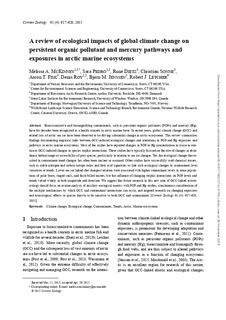| dc.description.abstract | Bioaccumulative and biomagnifying contaminants, such as persistent organic pollutants (POPs) and mercury (Hg), have for decades been recognized as a health concern in arctic marine biota. In recent years, global climate change (GCC) and related loss of arctic sea ice have been observed to be driving substantial change in arctic ecosystems. This review summarizes findings documenting empirical links between GCC-induced ecological changes and alterations in POP and Hg exposures and pathways in arctic marine ecosystems. Most of the studies have reported changes in POP or Hg concentrations in tissue in relation to GCC-induced changes in species trophic interactions. These studies have typically focused on the role of changes in abundance, habitat range or accessibility of prey species, particularly in relation to sea ice changes. Yet, the ecological change that resulted in contaminant trend changes has often been unclear or assumed. Other studies have successfully used chemical tracers, such as stable nitrogen and carbon isotope ratios and fatty acid signatures to link such ecological changes to contaminant level variations or trends. Lower sea ice linked-diet changes/variation were associated with higher contaminant levels in some populations of polar bears, ringed seals, and thick-billed murres, but the influence of changing trophic interactions on POP levels and trends varied widely in both magnitude and direction. We suggest that future research in this new area of GCC-linked ecotoxicology should focus on routine analysis of ancillary ecological metrics with POP and Hg studies, simultaneous consideration of the multiple mechanisms by which GCC and contaminant interactions can occur, and targeted research on changing exposures and toxicological effects in species known to be sensitive to both GCC and contaminants. | nb_NO |
